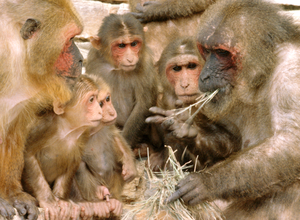Bear macaque
| Bear macaque | ||||||||||||
|---|---|---|---|---|---|---|---|---|---|---|---|---|

Bear macaque ( Macaca arctoides ) |
||||||||||||
| Systematics | ||||||||||||
|
||||||||||||
| Scientific name | ||||||||||||
| Macaca arctoides | ||||||||||||
| I. Geoffroy Saint-Hilaire , 1831 |
The bear or stump- tailed macaque ( Macaca arctoides ) is a primate species from the genus of macaques within the family of vervet monkeys (Cercopithecidae).
features
Bear macaques are named for their stocky build and short stubby tail, reminiscent of bears . Their fur is long, shaggy and dark brown in color. The hairless, reddish face is striking and can turn brown or black with age. Males are significantly larger and heavier than females, they reach a head trunk length of 52 to 65 centimeters and a weight of 9.9 to 10.2 kilograms. Females, on the other hand, are 49 to 59 centimeters long and weigh 7.5 to 9.1 kilograms. In both sexes, the tail is just a stub 3 to 7 centimeters long.
distribution and habitat
Bear macaques live in Southeast Asia , their range extends from eastern India and southern China to Thailand , Vietnam and the Malay Peninsula . Their habitat are forests, both in the plains and in the mountains up to an altitude of 2500 meters.
Way of life
These animals are diurnal, they mainly stay on the ground. They go to trees to sleep and sometimes to look for food, but they are not considered to be very skilled climbers. They live in groups of 25 to 30 animals made up of several males and females. Both genders develop a hierarchy within their group.
Bear macaques are omnivores , but fruits are the main focus of their diet. In addition, they also consume leaves and other plant material, but also insects, crabs, bird eggs and small vertebrates.
Reproduction
The mating usually takes place in October or November, after a gestation period of around six months, the female usually gives birth to a single young. Unlike other macaque species, newborn bear macaques are colored white. After about nine months, the cub is weaned. Sexual maturity occurs at around four years of age, and life expectancy is up to 30 years.
Bear macaques and people
Like humans, bear macaques tend to lose the hair on their heads with age. The pattern with which balding progresses largely corresponds to that of human men, but affects both sexes in bear macaques. Minoxidil , a drug that works against hair loss, was therefore initially tested on these animals in animal experiments .
Unlike some other macaque species, bear macaques avoid human proximity. The main threat is the destruction of its habitat; the IUCN has listed the species as endangered ("vulnerable") since 1996.
literature
- Thomas Geissmann : Comparative Primatology. Springer-Verlag, Berlin et al. 2003, ISBN 3-540-43645-6 .
Web links
- Macaca arctoides in the endangered Red List species the IUCN 2006 Posted by: S. Htun, R. J. Timmins, R. Boonratana, J. Das, 2008. Accessed January 2 of 2009.
- KA Cawthon Lang: Primate Factsheets: Stump-tailed macaque ( Macaca arctoides )

